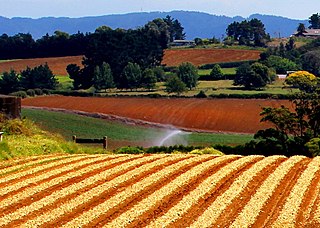
Puni is a rural locality in the Franklin ward of Auckland in the North Island of New Zealand. It is predominantly a dairy farming and market gardening area. The main type of crops grown are potatoes, carrots, and onions.

Rapaura is a locality northwest of Blenheim, New Zealand. The Wairau River flows past to the north. Spring Creek lies to the east.

Ōhura is a small town in the west of the North Island of New Zealand. It is located to the west of Taumarunui in the area known as the King Country, in inland Manawatū-Whanganui. It lies on the banks of the Mangaroa Stream, a tributary of the Ōhura River which is a tributary of the Whanganui River.

Eiffelton is a lightly populated locality in the Mid-Canterbury region of New Zealand's South Island.

Hinds is a small town in the Mid-Canterbury region of New Zealand's South Island. It is located on the Canterbury Plains on the south bank of the Hinds River, which reaches the Pacific Ocean between the nearby localities of Longbeach and Lowcliffe. Other localities around Hinds include Ealing to the west, Willowby, Windermere, and Winslow to the northeast, and Eiffelton to the southeast.
Lowcliffe is a lightly populated locality in the mid-Canterbury region of New Zealand's South Island. It is situated on the shore of the Pacific Ocean between the mouths of the Hinds and Rangitata Rivers. Nearby settlements include Coldstream to the west by the Rangitata River, Longbeach to the east on the other side of the Hinds River's mouth, and Hinds to the north. The closest towns of significant size are Ashburton to the northeast and Geraldine to the west.
Orari is a small town in the South Canterbury region of New Zealand's South Island, roughly midway between Ashburton to the north, and Timaru to the south it is the northernmost town of South Canterbury.
Oruaiti is a locality in Northland, New Zealand. It lies on state highway 10. Mangonui lies to the west, and Whangaroa Harbour to the east.
Pamapuria is a locality in Northland, New Zealand. It lies on State Highway 1 about 10 km east of Kaitaia.
Maromaku is a locality in the Northland Region of the North Island of New Zealand. Kawakawa is north, and Towai is southeast. State Highway 1 runs past Maromaku to the north, and the North Auckland Line runs through it.

Waitoki is a locality in the Rodney District of New Zealand. Wainui is approximately 5.5 kilometres to the north-east, Kaukapakapa 6.5 km to the north-west, and Dairy Flat 10 km to the south-east. The Wainui Stream joins the Waitoki Stream just to the north-east of the locality. The stream flows west into the Kaukapakapa River.

Arundel is a small rural village about 15 kilometres (9 mi) north of Geraldine, in the Canterbury region in the South Island of New Zealand. It is near the south bank of the Rangitata River, 3 kilometres (2 mi) from Peel Forest, an extensive podocarp forest with abundant birdlife. Arundel is flat and fertile, with fields and many mature trees.

Ashley is a small town in North Canterbury, in the South Island of New Zealand. It used to have a railway station on the Main North Line that runs through the village.
Ladbrooks is a locality in Canterbury, New Zealand. It is named after William and Eliza Ladbrook, who moved to the area in 1842 on the boat the Birman.

Rangitata is a settlement in New Zealand. It is located at the junction of State Highway 1 and State Highway 79. The Rangitata River is located 3 kilometres north of the town and 10.7 kilometres north of Orari.

Te Rahu is a rural locality in the Waipa District and Waikato region of New Zealand's North Island.
Fencourt is a rural locality in the Waipa District and Waikato region of New Zealand's North Island.

Pukerimu is a rural locality southwest of Cambridge in the Waipa District and Waikato region of New Zealand's North Island.
Honikiwi is a locality in the Ōtorohanga District and Waikato region of New Zealand. It is northwest of Ōtorohanga.
West Plains is a locality in the Southland Region of New Zealand, northwest of Invercargill and north of Otatara. Ōreti River and its tributary Makarewa River flow through the plains. It is part of the Southland Plains.











